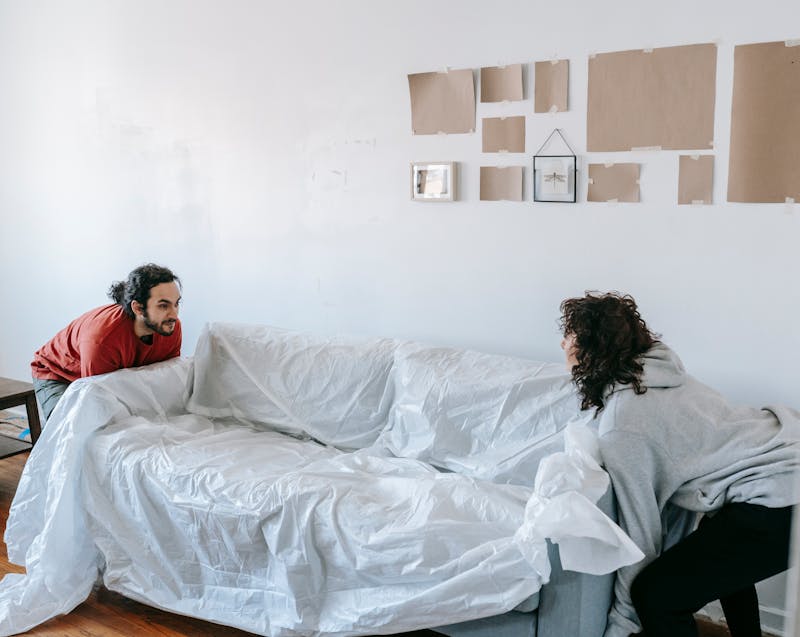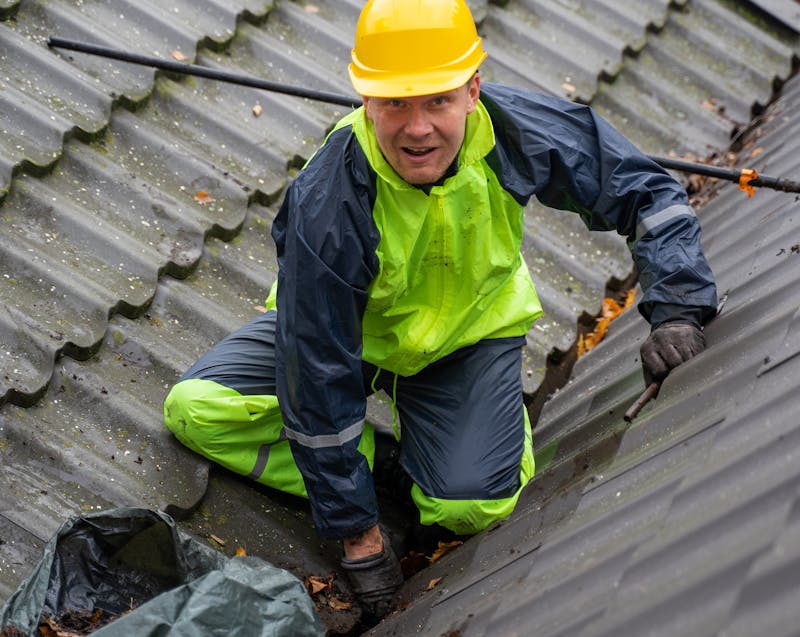- Act quickly to minimize damage — move valuables, contain water, and relieve pressure from bulging ceilings.
- Temporary fixes can buy time — use plastic sheeting, roofing tape, tar, or a bucket-and-hose setup to control leaks until professional help arrives.
- Dry and ventilate the area — fans, dehumidifiers, and proper airflow prevent mold and long-term structural issues.
- Document everything for insurance — photos, videos, and receipts strengthen your claim for repair costs.
- Professional repairs are essential — temporary measures won’t solve the root cause; call a licensed roofer.
- Prevention is key — regular inspections, gutter cleaning, and roof maintenance reduce the risk of future leaks.
Roof leaks rarely happen at a convenient time. Whether it’s a torrential downpour in the middle of the night or water dripping unexpectedly during a storm, homeowners often need a quick, temporary solution before professional roofers can assess and repair the damage. Knowing how to handle a roof leak from the inside can save you from significant water damage, protect your belongings, and give you peace of mind until expert help arrives.
In this guide, we’ll explore emergency steps every homeowner should take when facing a roof leak. From identifying the source to setting up makeshift repairs, you’ll learn practical methods to minimize damage and safeguard your home. While these measures are temporary, they are crucial in preventing further complications until permanent repairs can be made.
Why Acting Quickly on a Roof Leak Matters
When water begins to seep through the ceiling, it’s more than just a nuisance. Roof leaks can cause hidden structural damage, compromise your insulation, and promote mold growth if left unattended. Acting quickly ensures you’re not dealing with thousands of dollars in avoidable repairs later.
A roof leak, even a small one, is a signal that your home’s protective barrier has been compromised. Water follows the path of least resistance, which means the visible drip may not be directly below the actual leak. It can travel along beams, electrical wiring, and insulation before showing up inside. This makes fast intervention not just necessary, but essential to limit damage.
In the following sections, we’ll cover both immediate damage control and practical, do-it-yourself methods to fix a roof leak from the inside.
Step 1: Identify the Source of the Leak
Before you can attempt any repairs, you need to know where the water is coming from. This step can be tricky, as the point where water enters your home is not always where it appears on your ceiling.
Tips for Locating the Leak
- Look for stains or bulges on your ceiling or walls—these usually mark the path of water.
- Check your attic, if it’s safe to enter. Use a flashlight to inspect the rafters and insulation for wet spots, dark stains, or mold.
- Listen carefully during rainfall. Sometimes, the sound of dripping water can guide you to the source.
- Trace water flow along beams. Water often travels before dripping down, so follow the trail to locate the entry point.
Identifying the source is not always straightforward, but doing so can help you take targeted action and provide useful information to your roofing contractor.
Step 2: Minimize Immediate Damage

Once you spot the signs of a roof leak, your priority should be to prevent further harm to your home’s interior.
Protective Actions to Take Immediately
- Move furniture and valuables: Clear the affected area of electronics, furniture, and personal belongings to avoid damage.
- Contain the water: Place a large bucket or container under the drip to catch water.
- Use plastic sheeting or tarps: If water is spreading across the ceiling, cover floors and furniture with plastic tarps for extra protection.
- Relieve pressure from bulging ceilings: If water is pooling behind paint or drywall, carefully puncture the bulge with a small hole using a screwdriver. This controlled release prevents a sudden collapse.
Quick action here can mean the difference between a minor inconvenience and a costly disaster.
Step 3: How to Fix a Roof Leak from the Inside (Temporary Measures)
Now that the immediate damage is under control, you can attempt temporary fixes to stop or slow the leak until professional roofers arrive. These methods are not permanent, but they can buy you valuable time.
Plastic Sheeting Method
- Cut a piece of heavy-duty plastic sheeting (polyethylene) large enough to cover the leak area.
- Secure it with staples or roofing tape to create a waterproof barrier.
- For added reinforcement, overlap multiple sheets if needed.
Roofing Tape or Sealant
- Apply waterproof roofing tape directly to the source of the leak inside the attic.
- If accessible, use roof sealant (caulking) around the leak area. This can temporarily plug small cracks or holes.
Patch with Plywood and Roofing Tar
- If the leak is concentrated in a specific spot, use a small piece of plywood to cover it.
- Spread roofing tar around the edges and press the plywood firmly in place.
- Seal the edges with more tar to prevent water penetration.
Use a Bucket and Hose Method (for Attic Leaks)
- Place a large container under the leak in your attic.
- Attach a hose to the container, leading the water out through a window or vent.
- This directs water safely outside instead of pooling indoors.
These solutions are practical, affordable, and easy to execute with basic household materials.
Step 4: Dry and Ventilate the Area
After temporarily stopping the leak, the next priority is drying the affected areas. Moisture trapped inside your home can quickly lead to mold growth and structural deterioration.
Drying Techniques for Homeowners
- Use fans to circulate air around the wet area.
- Run a dehumidifier to reduce humidity levels in the room.
- Remove wet insulation and replace it once repairs are complete.
- Keep windows open (weather permitting) to allow airflow.
Taking these steps prevents long-term issues, particularly mold, which can pose health risks to your household.
Step 5: Document the Damage for Insurance
Many homeowners overlook this step in the stress of handling a roof leak. However, documenting damage can help with insurance claims and ensure you receive fair compensation for repairs.
How to Properly Document Roof Leak Damage
- Take clear photos of the leak, ceiling damage, and any affected furniture or belongings.
- Record videos to capture water dripping or pooling.
- Keep receipts of any supplies you purchased for temporary fixes.
- Contact your insurance provider as soon as possible to report the incident.
Thorough documentation ensures you won’t face unnecessary financial burden once the permanent repair process begins.
Step 6: Call a Professional Roofer
Even if your temporary fix seems effective, remember that it’s only a stopgap. A licensed roofing contractor should inspect your roof to identify the root cause and recommend permanent solutions.
Professional roofers have the expertise, tools, and materials to address the underlying issues—whether it’s damaged shingles, deteriorated flashing, or structural problems. Attempting to fully repair a roof on your own can be dangerous and may void warranties or insurance coverage.
When contacting a roofer, provide the following:
- Details about when and how the leak occurred.
- Photos or videos you captured.
- Any temporary repairs you made.
This information helps them diagnose and repair the issue more efficiently.
Common Causes of Roof Leaks Homeowners Should Know
Understanding why leaks happen can help you prevent future incidents. Here are some of the most frequent causes:
- Damaged or missing shingles: Strong winds and storms can lift or break shingles.
- Clogged gutters: When gutters overflow, water can back up under your roof.
- Cracked flashing: Flashing seals roof joints; when it fails, water finds its way inside.
- Skylight or chimney leaks: Poor sealing or aging components often lead to leaks around these structures.
- Aging roofs: Roofs naturally degrade over time, making them more susceptible to water intrusion.
Regular inspections and maintenance go a long way toward avoiding these issues.
Preventing Roof Leaks in the Future

While knowing how to fix a roof leak from the inside is valuable, prevention is always better than cure. As a homeowner, incorporating regular roof maintenance can minimize the risk of unexpected leaks.
Preventive Measures for Homeowners
- Inspect your roof twice a year, especially after major storms.
- Clean gutters and downspouts regularly to prevent water buildup.
- Trim overhanging branches that may damage shingles during storms.
- Check attic insulation and ventilation to prevent moisture buildup.
- Schedule professional roof inspections annually to catch issues early.
By staying proactive, you’ll not only avoid costly repairs but also extend the life of your roof.
Safety Tips to Keep in Mind
Dealing with a roof leak can be stressful, but safety should always come first.
- Avoid climbing on the roof during storms or when wet. Slippery surfaces can be extremely dangerous.
- Wear protective gear like gloves, goggles, and a mask when handling insulation or applying sealant.
- Use proper lighting when inspecting your attic to prevent falls or accidents.
- Do not attempt electrical repairs if water has reached wiring—call an electrician immediately.
Remember, your goal is to contain the problem until professionals arrive, not to put yourself at risk.
Final Thoughts: Be Prepared Before the Next Storm
Roof leaks can strike unexpectedly, causing panic for many homeowners. The key to minimizing damage lies in knowing what to do immediately and executing those steps calmly. By identifying the source, containing the water, applying temporary fixes, and documenting the damage, you can protect your home until professional roofers arrive.
Equally important is prevention. Regular maintenance, timely inspections, and taking care of small issues before they escalate are the best defenses against roof leaks. While you can’t always control the weather, you can control how prepared you are when the next storm hits.
Being equipped with these emergency tips not only saves you money but also gives you confidence and peace of mind as a homeowner.

